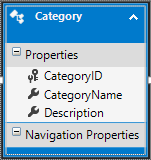In my last post, we saw how to Serialize Object to XML and Deserialize XML to Object using a generic function, now we will see how to save the deserialized object in a database using entity framework.
The source code is here!.
First I created a database called “WCF” with SQL Server 2012 Express, and created a table called Categories
USE [WCF]
GO
/****** Object: Table [dbo].[Categories] Script Date: 7/14/2014 7:17:26 PM ******/
SET ANSI_NULLS ON
GO
SET QUOTED_IDENTIFIER ON
GO
CREATE TABLE [dbo].[Categories](
[CategoryID] [int] NOT NULL,
[CategoryName] [nvarchar](15) NOT NULL,
[Description] [ntext] NULL,
CONSTRAINT [PK_Categories] PRIMARY KEY CLUSTERED
(
[CategoryID] ASC
)WITH (PAD_INDEX = OFF, STATISTICS_NORECOMPUTE = OFF, IGNORE_DUP_KEY = OFF, ALLOW_ROW_LOCKS = ON, ALLOW_PAGE_LOCKS = ON) ON [PRIMARY]
) ON [PRIMARY] TEXTIMAGE_ON [PRIMARY]
GONow with the same solution, I add another class project for my EntityFramework called “WcfServicesXmlSample.DO”, and add the table as a Entity

Now we need to create our ViewModel
[DataContract]
public class CategoriesViewModel
{
[DataMember]
public int CategoryID { get; set; }
[DataMember]
public string CategoryName { get; set; }
[DataMember]
public string Description { get; set; }
}In my interface I add my method
[OperationContract]
Task<CategoriesViewModel> CategoriesDeSerialize(string xmlString);Our method inheritance from Interface
public async Task<CategoriesViewModel> CategoriesDeSerialize(string xmlString)
{
if (xmlString == null)
{
throw new ArgumentNullException("categories");
}
try
{
CategoriesViewModel categories = GenericDataContractSerializer<CategoriesViewModel>.DeserializeXml(xmlString);
var result = Mapper.Map<CategoriesViewModel, Category>(categories);
using (var context = new WCFEntities())
{
bool categoryAvailable = context.Categories.Any(x => x.CategoryID == result.CategoryID);
if (categoryAvailable == false)
{
context.Categories.Add(result);
await context.SaveChangesAsync();
return categories;
}
else
{
context.Categories.Attach(result);
context.Entry(result).State = EntityState.Modified;
await context.SaveChangesAsync();
return categories;
}
}
}
catch (Exception ex)
{
throw new ArgumentNullException("Error to Save.", ex);
}
}So as you can see, I’m using Automapper to mapping my Entity to my ViewModel, also I added a condition if the ID of the XML already exist, just Update the data, otherwise, saved as a new record.
And the XML input should be like this:
<Categories>
<CategoryID>3</CategoryID>
<CategoryName>Hello World</CategoryName>
<Description>Hello World Description</Description>
</Categories>